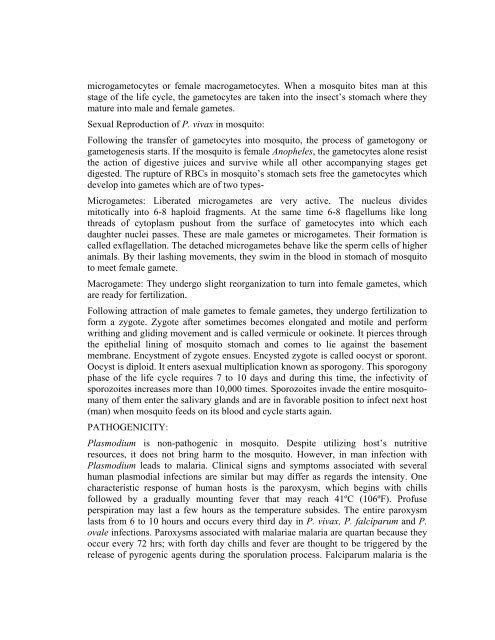ANIMAL DIVERSITY – I (NON-CHORDATES)
ANIMAL DIVERSITY – I (NON-CHORDATES)
ANIMAL DIVERSITY – I (NON-CHORDATES)
You also want an ePaper? Increase the reach of your titles
YUMPU automatically turns print PDFs into web optimized ePapers that Google loves.
microgametocytes or female macrogametocytes. When a mosquito bites man at this<br />
stage of the life cycle, the gametocytes are taken into the insect’s stomach where they<br />
mature into male and female gametes.<br />
Sexual Reproduction of P. vivax in mosquito:<br />
Following the transfer of gametocytes into mosquito, the process of gametogony or<br />
gametogenesis starts. If the mosquito is female Anopheles, the gametocytes alone resist<br />
the action of digestive juices and survive while all other accompanying stages get<br />
digested. The rupture of RBCs in mosquito’s stomach sets free the gametocytes which<br />
develop into gametes which are of two types-<br />
Microgametes: Liberated microgametes are very active. The nucleus divides<br />
mitotically into 6-8 haploid fragments. At the same time 6-8 flagellums like long<br />
threads of cytoplasm pushout from the surface of gametocytes into which each<br />
daughter nuclei passes. These are male gametes or microgametes. Their formation is<br />
called exflagellation. The detached microgametes behave like the sperm cells of higher<br />
animals. By their lashing movements, they swim in the blood in stomach of mosquito<br />
to meet female gamete.<br />
Macrogamete: They undergo slight reorganization to turn into female gametes, which<br />
are ready for fertilization.<br />
Following attraction of male gametes to female gametes, they undergo fertilization to<br />
form a zygote. Zygote after sometimes becomes elongated and motile and perform<br />
writhing and gliding movement and is called vermicule or ookinete. It pierces through<br />
the epithelial lining of mosquito stomach and comes to lie against the basement<br />
membrane. Encystment of zygote ensues. Encysted zygote is called oocyst or sporont.<br />
Oocyst is diploid. It enters asexual multiplication known as sporogony. This sporogony<br />
phase of the life cycle requires 7 to 10 days and during this time, the infectivity of<br />
sporozoites increases more than 10,000 times. Sporozoites invade the entire mosquitomany<br />
of them enter the salivary glands and are in favorable position to infect next host<br />
(man) when mosquito feeds on its blood and cycle starts again.<br />
PATHOGENICITY:<br />
Plasmodium is non-pathogenic in mosquito. Despite utilizing host’s nutritive<br />
resources, it does not bring harm to the mosquito. However, in man infection with<br />
Plasmodium leads to malaria. Clinical signs and symptoms associated with several<br />
human plasmodial infections are similar but may differ as regards the intensity. One<br />
characteristic response of human hosts is the paroxysm, which begins with chills<br />
followed by a gradually mounting fever that may reach 41ºC (106ºF). Profuse<br />
perspiration may last a few hours as the temperature subsides. The entire paroxysm<br />
lasts from 6 to 10 hours and occurs every third day in P. vivax, P. falciparum and P.<br />
ovale infections. Paroxysms associated with malariae malaria are quartan because they<br />
occur every 72 hrs; with forth day chills and fever are thought to be triggered by the<br />
release of pyrogenic agents during the sporulation process. Falciparum malaria is the
















